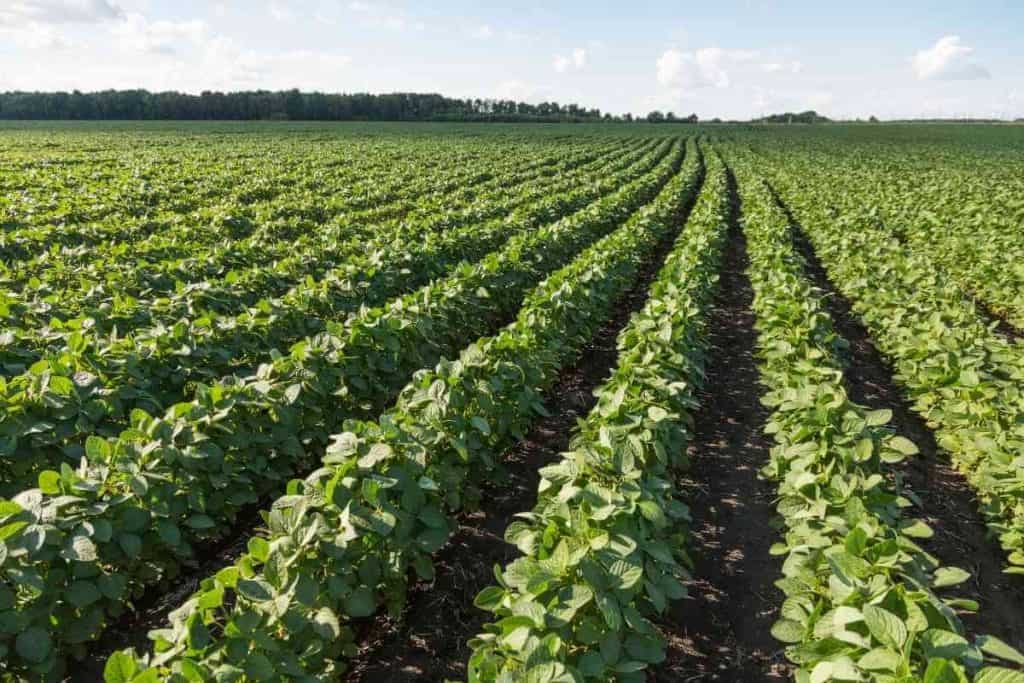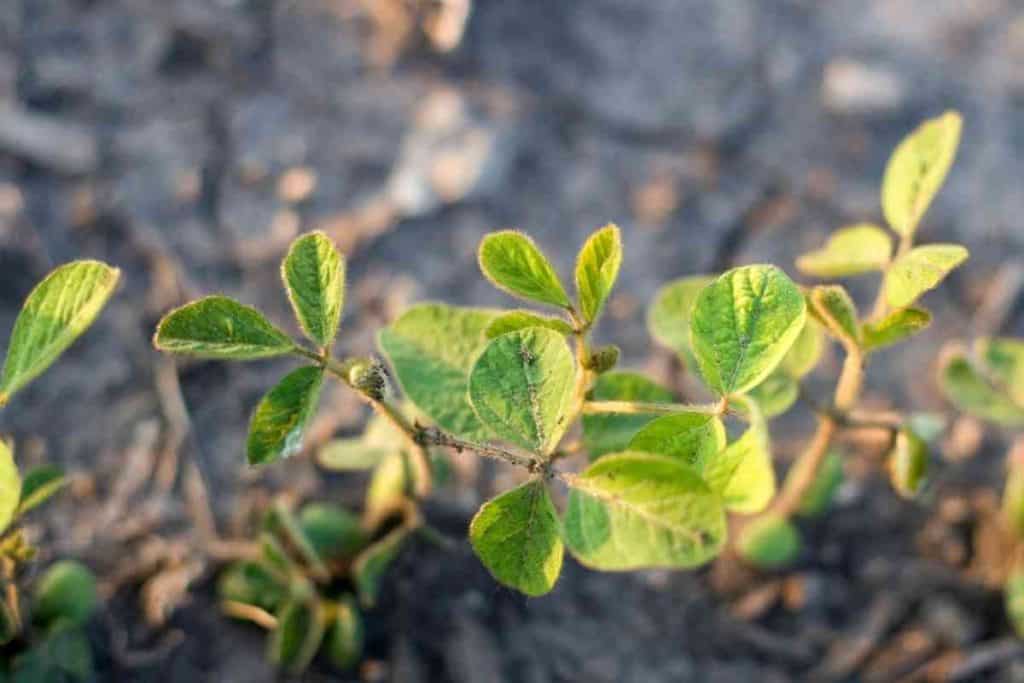The soybean is a plant with two embryonic leaves, which is why it is a dicotyledonous plant.
It has an epigeal growth system because the cotyledons sprout above the surface of the soil. Understanding the soybean growth stages is essential in improving the plant’s yield and healthy growth, as the effects of its care factors are determined by its growth stages.
The soybeans have 2 primary growth stages, namely vegetative growth stages (V) and reproductive growth stages (R). Both the vegetative stages and the reproductive stages are further subdivided or classified numerically using their common names.
For instance, we have the VE, VC, V1, V2, etc., for the former and R1, R2, R3, etc., for the latter. More details on the different stages of soybean growth later.
Table of Contents
What Is Soybean?
Scientifically called Glycine max, soybean is a leguminous plant that comes from the same family as clover, peas, and alfalfa and can grow over 2 meters (6.5ft) tall.
Also known as soja beans or soya beans, the soybean is widely considered the best bean globally economically.
It is the most important as it offers vegetable protein for lots of people and provides essential ingredients for many chemical products.
The soybean is cultivated in over 30 states by over 500,000 U.S. farmers. We get several nutritional elements from the soybean ranging from oil, protein-rich meal, and hulls.
So many scientists worldwide believe that the domestication of the soybean began in central China in the 11th century B.C. And since then, it has spread to other areas and has been used as a source of food and medicine for thousands of years, especially in Japan and Korea.
It entered the U.S. in 1804 and, during the mid 20th century, became an essential product in the south and Midwest areas; even Brazil and Argentina became one of its major manufacturers.
The soybean features self-fertilizing flowers with white or a shade of purple color. It grows yellow, green, brown, black, or mixed-color seeds.
Commercially, most soybean varieties come in brown or tan seeds featuring 1 to 4 seeds for each pod. It grows best in warm, fertile, well-drained, sandy loam and is planted after the frost season.
The plant emits nitrogen into the soil through nitrogen-fixing bacteria and is best harvested after its leaves fall and seed moisture content drops to 13 percent.
Different Soybean Growth Stages

Now, let’s look at the soybean growth stages:
As we mentioned earlier, understanding the different growth stages of soybean is critical in improving the plant’s yield and healthy growth, as the effects of its care factors are determined by its growth stages.
Again, with the growth stages, you’ll know what stage they are at a particular time, thereby helping you plan and time your planting accordingly.
The soybeans can be divided into two significant growth stages, namely vegetative growth stages (V) and reproductive growth stages (R). Both the vegetative stages and the reproductive stages are further subdivided or classified numerically using their common names.
The stages of soybean growth start from the emergence of cotyledons from the surface of the soil (VE). The emergence of the unifoliate leaves shows that the plant has gotten to the VC stage.
Once the first trifoliate leaves have enlarged, you can use numbers to indicate every vegetative (V) and reproductive (R) growth stage.
And when it has started blooming, it is termed the reproductive stage, and the plant moves on through pod development, seed development, and maturity level.
On the other hand, the vegetative stages of growth start to overlap reproductive stages at around R1. If 50% of the plant or over meets the needs of the growth stage, it will breed a new growth stage.
The following are a brief highlight of the soybean growth stages;
Vegetative Growth Stages of Soybean
Stage 1: Emergence (VE)
This is the stage in which cotyledons have emerged above the soil surface. After soaking up sufficient moisture and given normal conditions, the primary root will begin to sprout from soybean seed and drags the cotyledons with it across the surface of the soil (VE).
Cotyledons provide the plant with the required nutrients between 7 to 10 days after emerging. At this stage, losing any cotyledon will hinder the plant’s development. Yet, losing two cotyledons during or after VE will minimize your potential harvest to the 5-10% mark.
Once the cotyledons have wholly emerged, it will allow the emergence of unifoliate leaves at the second node and start producing energy via photosynthesis (VC stage).
When the first trifoliate leaflets (node 3) are fully developed and expanded, it will establish the V1 growth stage. Each completely developed trifoliate on the primary stem comes a new V stage.
Stage 2: Second Trifoliate (V2)
The V2 stage culminates in the establishment of the second trifoliate leaf, where the nodules start their development. It is at this stage that the soybean plant releases its nitrogen.
At this time, the plant must’ve grown up to 6 to 8 inches tall. Once it starts witching from soil-available N to fixed N, the plant’s color changes to yellow, and lateral roots emerge quickly in the top 6 inches of the soil.
Stage 3: Third to Fifth Trifoliate (V3 to V5)
During this stage, axillary buds will begin to grow into flower clusters called racemes in the stem top.
As soon as blooming has begun, the determinate varieties stop growing nodes on their primary stem. As long as the indeterminate varieties are concerned, the average number of nodes produced by the plant on its primary stem is fixed at V5.
Axillary buds that produce an indeterminate variety can enhance plants’ recovery from damage. At this time, there are apparent signs of chlorosis deficiency in impacted fields.
Stage 4: Sixth Trifoliate (V6)
Plants tend to produce new growth stages every 3 days, but it depends on their environmental situations. This stage comes when the lateral roots overlap in at least 30-inch rows.
If the leaves experience about 50% loss, it can minimize potential harvest by up to 3%.
Reproductive Growth Stages of Soybean

Stage 1: Beginning Flowering (R1)
The soybean starts to bloom during the third to sixth node and progresses up and down the primary stem, then to the branches.
The nodes found on the primary stem often feature over one or two flowers. Straight roots, secondary roots, and root hairs keep on growing quickly until R4 or R5.
Stage 2: Full Flowering (R2)
One of the top two nodes of the primary stem produces an open bloom. The soybean has acquired around 25% of its average dry weight and nutrients and around 50% of its adult height. At this point, nitrogen fixation via root nodules is quickly growing.
There may be a reduction of potential plant harvest by 6% because of the 50% loss of its leaves to hail, insects, or disease at any point.
Stage 3: Beginning Pod (R3)
Pods are 3/16 inch (5mm) at one of the four uppermost nodes. If the plant undergoes any heat or moisture during this stage, it can decrease pod numbers, seed number per pod, or seed size, thus decreasing harvest.
The chances of soybeans surviving from short-term stress reduce from R1 to R5. Good growing situations at this time could produce a high pod number and greater harvest.
Stage 4: Full Pod (R4)
At this stage, pods keep increasing at a quicker rate while seeds keep on growing.
Pods are ¾ inch (2cm) at one of the four topmost nodes. Stress at this time could result in a decrease in harvest than during other stages of growth. Prompt rainfall or irrigation could increase the chances of a better harvest.
Stage 5: Beginning Seed (R5)
This stage coincides with one ⅛ inch long seed contained in a pod at one of the four topmost nodes on the primary stem with a completely grown leaf.
Almost half of the nutrients needed for the filling of seed are gotten out of the soybean’s vegetative components and around half from Nitrogen fixation and nutrient absorption by the roots.
Nitrogen fixation is at its highest level. During this period, stress could decrease the numbers of pods, seed numbers for each pod, seed size, and harvest.
Also, during this stage, plants reach their greatest height, node number, and leaf location.
Stage 6: Full Seed (R6)
This is the green bean stage, which marks the start of the entire seed period when only one of four upper nodes features a pod with a green seed filling the pod cavity. Here, general pod weight is at its highest, and the color of leaves turns yellow.
Stage 7: Beginning Maturity (R7)
Here, you’ll find one normal pod on the primary stem reaching its mature pod color (brown or tan). Also, seed dry matter starts to peak, and the seeds and pods start changing their color from green.
It makes plants free from frost danger. Harvest could decrease if pods are hit by plants or seeds are destroyed from pods.
Stage 8: Full Maturity
This is the stage at which about 95% of the pods get to their mature color, as the plant is entirely mature.
Significantly, it’ll take about 5-10 days of proper drying weather after reaching the R8 period to gain a yield seed moisture content of at least 15%.
Related Posts:
- Chili Plant Growing Stages
- Pomegranate Growing Stages
- Different Garlic Growing Stages
- Different Carrots Growing Stages
- Cauliflower Growing Stages




